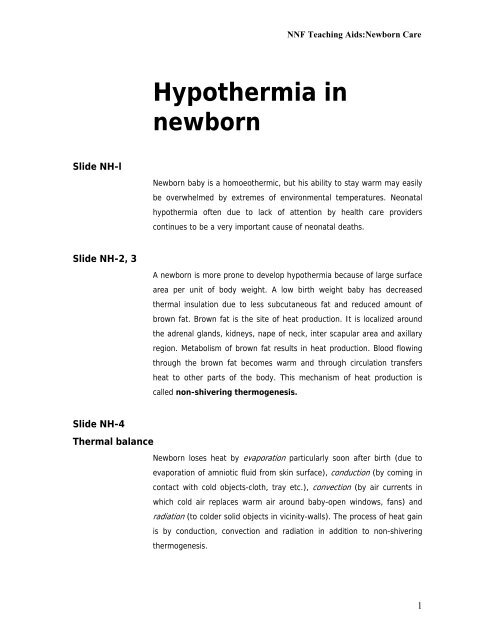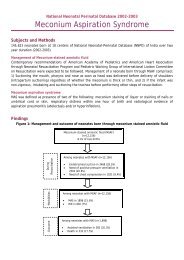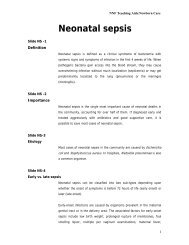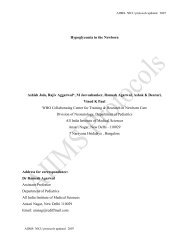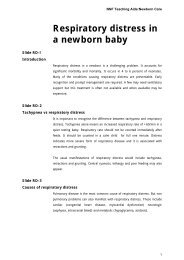Hypothermia in newborn - New Born Baby
Hypothermia in newborn - New Born Baby
Hypothermia in newborn - New Born Baby
You also want an ePaper? Increase the reach of your titles
YUMPU automatically turns print PDFs into web optimized ePapers that Google loves.
Slide NH-l<br />
Slide NH-2, 3<br />
Slide NH-4<br />
Thermal balance<br />
<strong>Hypothermia</strong> <strong>in</strong><br />
<strong>newborn</strong><br />
NNF Teach<strong>in</strong>g Aids:<strong>New</strong>born Care<br />
<strong>New</strong>born baby is a homoeothermic, but his ability to stay warm may easily<br />
be overwhelmed by extremes of environmental temperatures. Neonatal<br />
hypothermia often due to lack of attention by health care providers<br />
cont<strong>in</strong>ues to be a very important cause of neonatal deaths.<br />
A <strong>newborn</strong> is more prone to develop hypothermia because of large surface<br />
area per unit of body weight. A low birth weight baby has decreased<br />
thermal <strong>in</strong>sulation due to less subcutaneous fat and reduced amount of<br />
brown fat. Brown fat is the site of heat production. It is localized around<br />
the adrenal glands, kidneys, nape of neck, <strong>in</strong>ter scapular area and axillary<br />
region. Metabolism of brown fat results <strong>in</strong> heat production. Blood flow<strong>in</strong>g<br />
through the brown fat becomes warm and through circulation transfers<br />
heat to other parts of the body. This mechanism of heat production is<br />
called non-shiver<strong>in</strong>g thermogenesis.<br />
<strong>New</strong>born loses heat by evaporation particularly soon after birth (due to<br />
evaporation of amniotic fluid from sk<strong>in</strong> surface), conduction (by com<strong>in</strong>g <strong>in</strong><br />
contact with cold objects-cloth, tray etc.), convection (by air currents <strong>in</strong><br />
which cold air replaces warm air around baby-open w<strong>in</strong>dows, fans) and<br />
radiation (to colder solid objects <strong>in</strong> vic<strong>in</strong>ity-walls). The process of heat ga<strong>in</strong><br />
is by conduction, convection and radiation <strong>in</strong> addition to non-shiver<strong>in</strong>g<br />
thermogenesis.<br />
1
Slide NH-5<br />
Thermo neutral environment<br />
Slide NH-6<br />
Def<strong>in</strong>ition<br />
Slide NH-7<br />
Temperature record<strong>in</strong>g<br />
NNF Teach<strong>in</strong>g Aids:<strong>New</strong>born Care<br />
The temperature range dur<strong>in</strong>g which the basal metabolic rate of the baby<br />
is at a m<strong>in</strong>imum, oxygen utilization is least and baby thrives well is known<br />
as 'Thermo- neutral range of temperature' or 'Neutral Thermal<br />
Environment'. For each baby, this range of temperature varies depend<strong>in</strong>g<br />
on gestational age.<br />
Normal axillary temperature is 36.5-37.5°C.<br />
In hypothermia the temperature is below 36.5 degree centigrade.<br />
Cold stress 36.0°C to 36.4°C<br />
Moderate hypothermia 32.0°C to 35.9°C<br />
Severe hypothermia
Slide NH-8<br />
Human touch<br />
Slide NH-9<br />
NNF Teach<strong>in</strong>g Aids:<strong>New</strong>born Care<br />
Rectal temperature is not recorded as a standard procedure <strong>in</strong><br />
neonate. Record rectal temperature only for sick hypothermic<br />
neonates.<br />
The concept of "Warm Cha<strong>in</strong>"<br />
(c) Sk<strong>in</strong> temperature: Sk<strong>in</strong> temperature is recorded by a thermister. The<br />
probe of the thermister is attached to the sk<strong>in</strong> over upper abdomen.<br />
The thermister senses the sk<strong>in</strong> temperature and displays it on the<br />
panel.<br />
<strong>Baby</strong>'s temperature can be assessed with reasonable precision by human touch,<br />
the reliability of which can be enhanced by tra<strong>in</strong><strong>in</strong>g. Abdom<strong>in</strong>al temperature is<br />
representative of the core temperature and it is reliable <strong>in</strong> the diagnosis of<br />
hypothermia.<br />
The warm and p<strong>in</strong>k feet of the baby <strong>in</strong>dicate that the baby is <strong>in</strong> thermal<br />
comfort. But when feet are cold and trunk is warm it <strong>in</strong>dicates that the<br />
baby is <strong>in</strong> cold stress. In hypothermia both feet and trunk are cold to<br />
touch.<br />
<strong>Baby</strong> must be kept warm at the place of birth (home or hospital) and<br />
dur<strong>in</strong>g transportation for special care either from home to hospital or<br />
with<strong>in</strong> the hospital.<br />
Satisfactory control demands both prevention of heat loss and promotion<br />
of heat ga<strong>in</strong>. The "warm cha<strong>in</strong>" is a set of ten <strong>in</strong>terl<strong>in</strong>ked procedures<br />
carried out at birth and later, which will m<strong>in</strong>imize the likelihood of<br />
hypothermia <strong>in</strong> all <strong>newborn</strong>s.<br />
1. Warm delivery room (> 25°C)<br />
2. Warm resuscitation<br />
3. Immediate dry<strong>in</strong>g<br />
4. Sk<strong>in</strong>-to-sk<strong>in</strong> contact between baby and the mother<br />
5. Breastfeed<strong>in</strong>g<br />
6. Bath<strong>in</strong>g and weigh<strong>in</strong>g postponed<br />
3
Slide NH-1O<br />
7. Appropriate cloth<strong>in</strong>g and bedd<strong>in</strong>g<br />
8. Mother and baby together<br />
9. Warm transportation<br />
Prevention of hypothermia<br />
Slide NH-11, 12<br />
10. Tra<strong>in</strong><strong>in</strong>g/awareness of healthcare providers<br />
1. In the delivery room<br />
• Conduct delivery <strong>in</strong> a warm room<br />
NNF Teach<strong>in</strong>g Aids:<strong>New</strong>born Care<br />
• Immediately dry <strong>newborn</strong> with a clean soft preferably warm towel .Use<br />
another warm towel to wrap the baby <strong>in</strong> two layers<br />
• Ensure head is well covered<br />
• Keep the baby by the side of the mother (mothers' temperature will keep the<br />
baby warm)<br />
Bath<strong>in</strong>g of babies at birth is a dangerous practice and should be avoided.<br />
2. Sk<strong>in</strong>-to-sk<strong>in</strong> contact (The Kangaroo Method)<br />
"Kangaroo<strong>in</strong>g"<br />
(a) Assists <strong>in</strong> ma<strong>in</strong>ta<strong>in</strong><strong>in</strong>g the temperature of <strong>in</strong>fant<br />
(b) Facilitates breastfeed<strong>in</strong>g<br />
(d) Helps to <strong>in</strong>crease the duration of breastfeed<strong>in</strong>g<br />
(e) Improves mother <strong>in</strong>fant bond<strong>in</strong>g<br />
A baby who is born LBW (less than 2500 g) often needs special care <strong>in</strong> a<br />
hospital. If there are no signs of distress or extreme prematurity, a<br />
mother can provide warm environment by "Kangaroo<strong>in</strong>g" the baby at<br />
home or hospital.<br />
• Place the baby naked, with or without a nappy, upright <strong>in</strong>side mothers<br />
cloth<strong>in</strong>g aga<strong>in</strong>st the bare sk<strong>in</strong> over the chest. ( A loose blouse, sweater<br />
or wrap tied at the waist holds the baby)<br />
• Let baby suckle at breasts as often as he wants, but at least every 2<br />
hourly. Mother should sleep propped up so that the baby stays upright<br />
• Make sure the baby stays warm at all times.<br />
4
Slide NH-13, 14<br />
Slide NH-15<br />
NNF Teach<strong>in</strong>g Aids:<strong>New</strong>born Care<br />
• If environmental temperature is low, dress the baby with extra cloth<strong>in</strong>g<br />
and cover his head.<br />
• When mother wants to bathe or rest, ask the father or another family<br />
member to 'Kangaroo’ the baby or wrap <strong>in</strong>fant <strong>in</strong> several layers of<br />
warm cloth<strong>in</strong>g, covered with blankets and keep <strong>in</strong> a warm place.<br />
• Take baby for regular check ups for vacc<strong>in</strong>ation and weight record.<br />
For more details refer to chapter on Kangaroo mother care<br />
3. Bath<strong>in</strong>g the baby<br />
Bath<strong>in</strong>g should be avoided immediately after birth. Ensure before giv<strong>in</strong>g<br />
bath that temperature is normal. Preferably, give bath to normal baby on<br />
second day <strong>in</strong> summer. In w<strong>in</strong>ter bath<strong>in</strong>g may be avoided for several days.<br />
Postpone bath till next day <strong>in</strong> term baby ; no bath to babies who are sick /<br />
admitted <strong>in</strong> nursery ; Small &/or LBW baby- postpone till cord falls or<br />
preferably till weight is 2.5 kg .<br />
The nurse or attendant should follow the <strong>in</strong>structions for bath<strong>in</strong>g as given<br />
below.<br />
• Use warm room and warm water.<br />
• Bathe quickly and gently.<br />
• Dry quickly and thoroughly from head to toe.<br />
• Wrap <strong>in</strong> a warm, dry towel.<br />
• Dress and wrap <strong>in</strong>fant, use a cap on the head.<br />
• Place <strong>in</strong>fant close to mother.<br />
4. Cot-nurs<strong>in</strong>g <strong>in</strong> hospital (mother sick)<br />
• Adequately clothe the baby (<strong>in</strong>clud<strong>in</strong>g head, extremities)<br />
• Keep ambient atmospheric temperature warm for baby's weight and<br />
postnatal age (28-32°C)<br />
• Monitor body temperature frequently at least 3 hourly dur<strong>in</strong>g the <strong>in</strong>itial<br />
postnatal days.<br />
In cold weather wrap the baby well but <strong>in</strong> hot weather<br />
(or when baby has fever) use loose clothes.<br />
5
Slide NH-16<br />
Slide NH-17, 18<br />
NNF Teach<strong>in</strong>g Aids:<strong>New</strong>born Care<br />
5. Temperature ma<strong>in</strong>tenance dur<strong>in</strong>g transport (weakest l<strong>in</strong>k <strong>in</strong><br />
warm cha<strong>in</strong>)<br />
• Always stabilize the baby's temperature before transport.<br />
• Record temperature before transport and take remedial measures. If<br />
temperature cannot be documented, use touch to judge temperature.<br />
Hands and feet should be as warm as abdomen.<br />
• Carry the baby close to the chest of mother<br />
• Cover head, legs and hands. Avoid undress<strong>in</strong>g the <strong>in</strong>fant for clean<strong>in</strong>g,<br />
weigh<strong>in</strong>g or exam<strong>in</strong>ation. Postpone these until baby is warm.<br />
• Thermocol box with pre warmed l<strong>in</strong>en or plastic bubble sheet or silver<br />
swaddler may be used dur<strong>in</strong>g transport.<br />
• Water filled mattress with thermostat to control temperature may be<br />
used for transport ,if available.<br />
For more details refer to chapter on transport of sick <strong>newborn</strong><br />
Signs and symptoms of hypothermia<br />
(a) Peripheral vasoconstriction<br />
-Acrocyanosis<br />
-Cool extremities<br />
-Decreased peripheral perfusion<br />
(b) CNS depression<br />
-Lethargy<br />
-Bradycardia<br />
-Apnea<br />
-Poor feed<strong>in</strong>g<br />
(c) Increased metabolism<br />
-Hypoglycemia<br />
-Hypoxia<br />
-Metabolic acidosis<br />
(d) Increase of pulmonary artery pressure<br />
-Distress<br />
-Tachypnea<br />
6
Slide NH- 19, 20, 21<br />
(e) Chronic signs<br />
Management of hypothermia<br />
-Weight loss, poor weight ga<strong>in</strong><br />
NNF Teach<strong>in</strong>g Aids:<strong>New</strong>born Care<br />
At Health centre/FRU/Hospital confirm the diagnosis of hypothermia by<br />
record<strong>in</strong>g actual body temperature. A hypothermic baby has to be<br />
rewarmed as quickly as possible. The method selected will depend on the<br />
severity of hypothermia and availability of staff and equipment.<br />
The methods to use <strong>in</strong>clude<br />
- Sk<strong>in</strong>-to-sk<strong>in</strong> contact<br />
- a warm room or bed<br />
- a 200 watt bulb<br />
- a radiant heater or an <strong>in</strong>cubator<br />
Infection should be suspected if hypothermia persists despite above<br />
measures.<br />
Monitor axillary temperature every ½ hour till it reaches 36.5 °C, then<br />
hourly for next 4 hours, 2 hourly for 12 hours thereafter and 3 hourly as a<br />
rout<strong>in</strong>e.<br />
Moderate hypothermia (>32 to < 36°C)<br />
Sk<strong>in</strong>-to-sk<strong>in</strong> contact should be <strong>in</strong> a warm room and warm bed. Warmer /<br />
<strong>in</strong>cubator may be used, if available. Cont<strong>in</strong>ue rewarm<strong>in</strong>g till temperature<br />
reaches normal range. Monitor every 15-30 m<strong>in</strong>utes.<br />
Severe hypothermia (
Slide NH-22,23<br />
Hyperthermia<br />
Slide NH-24<br />
Conclusion<br />
In addition<br />
• take measures to reduce heat loss<br />
• start IV 10% Dextrose @ 60-80 ml/kg/day<br />
• give Inj Vit K 1 mg for term; 0.5 mg <strong>in</strong> preterm<br />
• provide oxygen<br />
NNF Teach<strong>in</strong>g Aids:<strong>New</strong>born Care<br />
Fever (temperature above 37. 5°C) is a sign of <strong>in</strong>fection usually <strong>in</strong> term<br />
neonate. In all febrile neonates, a diligent search for a possible <strong>in</strong>fective<br />
focus must be made. In summer months, hyperthermia may occur due to<br />
raised environmental temperature. This may be treated by mov<strong>in</strong>g the<br />
baby <strong>in</strong>to cool environment and us<strong>in</strong>g loose light clothes for the baby.<br />
When the temperature is 37.5°C-39°C, undress<strong>in</strong>g and expos<strong>in</strong>g the<br />
neonate to room temperature is usually all that is necessary. If the<br />
temperature is above 39°C, the neonate should be undressed and sponged<br />
with tepid water at approximately 35°C until the temperature is below<br />
38°C.Many times <strong>in</strong> nursery overheat<strong>in</strong>g under warmer is the cause rather<br />
than <strong>in</strong>fection.<br />
Do not use cold/ice water for sponge. Tap water is enough<br />
In conclusion, ma<strong>in</strong>ta<strong>in</strong><strong>in</strong>g a normothermic state <strong>in</strong> a <strong>newborn</strong> is an<br />
essential basic need <strong>in</strong> the early days of life. All efforts must be made to<br />
ma<strong>in</strong>ta<strong>in</strong> the warm cha<strong>in</strong>, detect hypothermia early and take prompt<br />
remedial measures to correct it. Specially LBW and at risk baby need close<br />
monitor<strong>in</strong>g and stricter preventive measures. This will significantly reduce<br />
the morbidity and mortality <strong>in</strong> the <strong>newborn</strong> period.<br />
8
For further read<strong>in</strong>g<br />
NNF Teach<strong>in</strong>g Aids:<strong>New</strong>born Care<br />
The <strong>in</strong>formation <strong>in</strong> this article is based on extensive cl<strong>in</strong>ical experience and<br />
read<strong>in</strong>g of availasble literature. This list<strong>in</strong>g conta<strong>in</strong>s some of the work that<br />
has been most useful.<br />
(1) Thermal control of the <strong>newborn</strong>: a practical guide.<br />
WHO/FHE/MSM/93.2.<br />
(2) Thermal protection of the <strong>newborn</strong>: a practical guide.<br />
WHO/RHT /MSM/97 .2.<br />
(3) Guidel<strong>in</strong>es for per<strong>in</strong>atal care. Second edition, American Academy of<br />
Pediatrics and American College of Obstetricians and Gynecologists,<br />
1988.<br />
(4) Essential <strong>newborn</strong> nurs<strong>in</strong>g for small hospital <strong>in</strong> resource restricted<br />
countries: Learner’s guide. Publication of Department of Pediatrics WHO-<br />
CC, <strong>New</strong> Delhi, 2004.<br />
9


